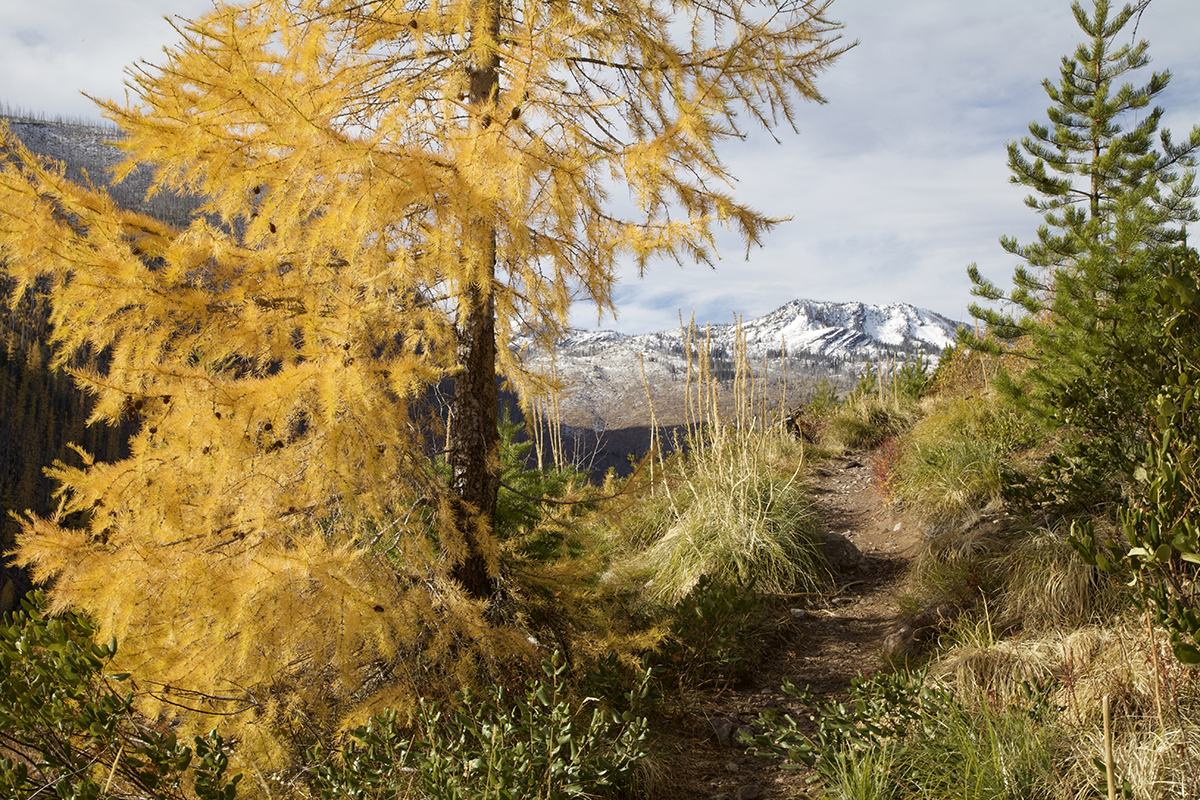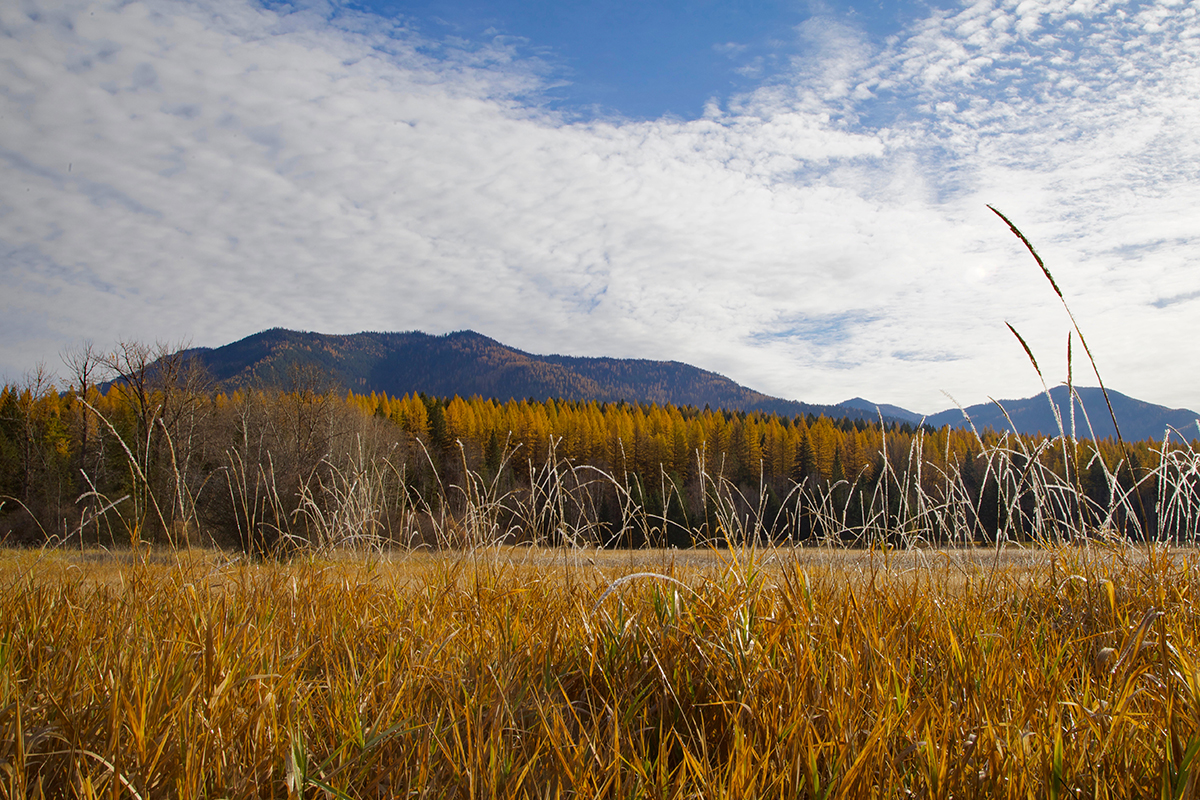Have you met Gus?
Tall, handsome and especially flamboyant in the fall when his crowning glory goes bright yellow, he is a Montana native, lives near Seeley Lake and is about 1,000 years old.
“Gus,” in fact, is the largest western larch tree in the country and probably the largest larch tree in the world at 163 feet tall and with a circumference of nearly 23 feet. This magnificent larch is located near the western shore of Seeley Lake in the 60-acre Girard Grove, which is considered one of the finest remaining larch stands in the United States.
The western larch is fast growing, with a long life span, and the largest of 10 species of larch worldwide. Also known as Larix occidentalis, western tamarack, mountain larch, Montana larch, and the Native American name of hackmatack, the tree has the unique character of being a conifer that bears needles like an evergreen, even though it is actually deciduous and loses its needles each fall. The delicately shimmering green needles turn golden before they flutter to the forest floor each October. The needles are surprisingly soft and grow on short spur twigs in bundles of 15-30.

Western larch trees are found locally in a number of areas, including the North and South Fork Flathead River basins, Yaak and Swan Valley. The tree also grows in the Bitterroot Valley as well as the east side of the Cascades, northeastern Oregon mountain areas, northern Idaho and Rocky Mountains of Alberta and British Columbia.
Another variety of larch tree, Larix lyallii or Lyall’s larch, also known as the alpine larch, is found in higher elevations. Alpine larch needles have four sides compared to the three-sided needle of the western larch. The resilient alpine larch grows in high-country areas such as wind-swept ridges that are often devoid of other trees, providing cover for wildlife and reducing the severity of avalanches on steep north slopes. Often the only trees, or at least the dominant trees in these high-altitude areas, the alpine larch stands out as it turns bright yellow in the fall. The trees are found locally in the Whitefish and Cabinet Ranges as well as the Swan and Mission Mountains.
Sweeping across mountainsides in October, the turning of the larch is the grand finale of the fall fireworks show. The colorful autumn exhibition usually begins in late August with a pop of color as smaller shrubs and plants turn various shades of red, yellow and orange in the high country. The show revs up as shrubs, flowers and trees in the valley spatter bursts of color when dry fields have turned pale and skies sometimes gray with smoke during seasonal fires. The glorious spectacle is fleeting, as each burst of autumn color fades and leaves fall. Then just when you think the show is almost over, the larches light up like torches rising from the darkness of evergreen forests: a sunny farewell to fall. Pure gold.

Western Larch Facts
• Grows to 60 meters
• Bark of mature trees is thick, deeply furrowed gray or brown plates
• Needles (leaves) are 1.5-2 inches long, 15-30 per spur
• Cones are small, papery with whiskers, 1-1.5 inches long
• When in stands, larches are usually bare for the first third to half of their height with nearly horizontal branches
• Grows on a variety of soils (most are deep and well-drained) in moist to wet forests
• Commonly found on valley floors, benches and north- and east-facing mountain slopes
• The larch is the most shade-intolerant conifer in the Northern Rockies
• Grows with other tree species, most commonly the Douglas fir
• Fire is essential to maintenance in natural forest stands, allowing seeds to germinate and thrive in a post-fire forest. The larch’s thick bark and early self-pruning of lower branches make it fire tolerant. Fire also prevents the sun-loving tree from becoming overrun by other species of trees.
• The close-grained, durable timber is used for lumber, fine veneer, utility poles, railroad ties, mine timbers and pulpwood, and the water-soluble gum is used in a variety of products including food, ink and food
• Native Americans chewed on the tree’s gummy substance (arabinogalactan), and decoctions made from the needles and branches were used for medicinal purposes
• In foods, larch arabinogalactan is used as a stabilizer, binder and sweetener
• Provides cover and food for a variety of wildlife

Meet “Gus”
• Height: 163 feet
• Trunk circumference: 264 inches
• Crown spread: 34 feet
• Tallied 426 points, which is determined by adding height, circumference and ¼ of average crown spread to determine champion trees
• Believed to have survived dozens of fires
• Nominated to the National Register of Champion Trees by Michael Krebs and Helen Smith in 2011
• Added to the National Register of Champion Trees in 2018
• Found in the Girard Grove, a 60-acre grove of old-growth larch, named after James W. Girard, who is a legend in the U.S. Forest Service for a lifetime of tree work including developing timber-measuring techniques
• The boardwalk circling Gus was constructed in 2017 to protect the tree’s roots by Seeley Lake Boy Scout Evan Yonce, as a final project to earn his Eagle Scout rank
How to Get There
Located just off Montana Highway 83: At the southern tip of Seeley Lake, drive north on Boy Scout Road for about 3 miles and cross the bridge at the outlet of Seeley Lake. Drive past Camp Paxson, and on the south side of the road you will find the Jim Girard Memorial Grove and Gus.
